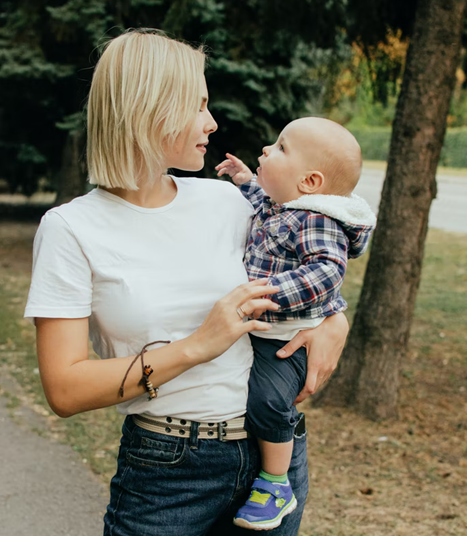13.3.1: Strategies that Support Language Development-Responsiveness and Sensitivity
- Page ID
- 140677
Responsiveness and Sensitivity
Responsiveness refers to a caregiver’s ability to detect and respond to a child's behavioral signals during shared interactions (Landry et al., 2001). Sensitivity refers to caregivers who are aware and capable of understanding a child’s behaviors and that respond to the child’s needs in a timely and appropriate manner (Grossmann, Bretherton, Waters & Grossmann, 2013). Thus responsiveness and sensitivity are related constructs that when implemented, support the language development of infants and toddlers (Alvarenga et al., 2021; Madigan et al., 2019). [1]

Infants and toddlers benefit from interacting with responsive and sensitive caregivers. For example, removing social feedback from interactions between caregivers and infants leads to fewer vocalizations from 5-month-old infants (Goldstein, Schwade & Bornstein, 2009), while providing social feedback in response to 8 month olds’ vocalizations results in a higher number of vocalizations (Goldstein, King & West, 2003). One study found that when children were 9 and 13 months old caregivers’ responsiveness predicted when children reached various language milestones, such as when children produced their first words and first fifty words (Tamis‐LeMonda, Bornstein & Baumwell, 2001). Both caregiver responsiveness and sensitivity are related to the development of expressive language abilities in toddlers (Bruce, Panneton & Taylor, 2022; Prime, Wade & Gonzalez, 2020) and higher levels of caregiver sensitivity during infancy are related to greater abilities in language comprehension in toddlerhood (Baumwell, Tamis-LeMonda & Bornstein, 1997). [3] [4]
To support language development, caregivers should participate in training sessions that practice and improve their ability to provide responsive and sensitive care and interactions with infants and toddlers. When caregivers do receive such training, their responsiveness improves and is linked to an improvement in communication abilities of infants (Alvarenga et al., 2021). Engaging in responsive and sensitive interactions not only takes practice, but also uninterrupted focused time with children. To be responsive, a caregiver must pay close attention to a child’s signals and to be sensitive, a caregiver must respond to their signals in a timely and appropriate way.
[1] Caldas et al., (2018). The socio-communicative development of preterm infants is resistant to the negative effects of parity on maternal responsiveness. Frontiers in Psychology, 9, 43. CC by 4.0
[2] Image by Alina Ryabchenko on Unsplash.
[1] Marklund et al., (2021). An association between phonetic complexity of infant vocalizations and parent vowel hyperarticulation. Frontiers in Psychology, 2873. CC by 4.0
[2] Dickinson et al., (2012). How reading books fosters language development around the world. Child Development Research. CC by 3.0

